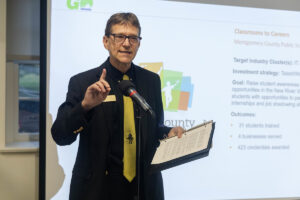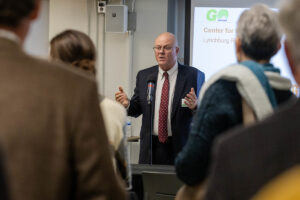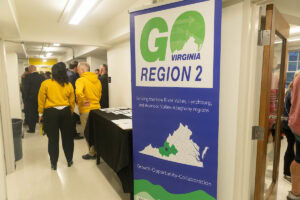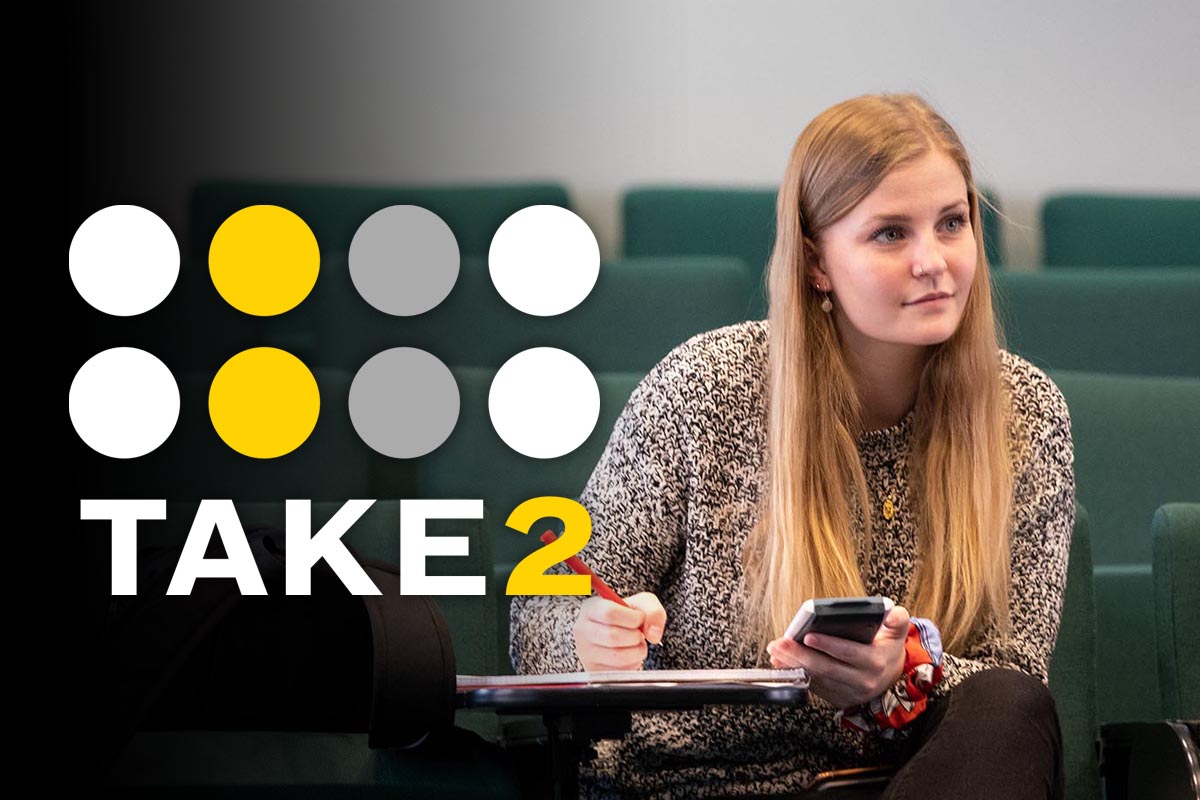Randolph holds ribbon cutting for new robotics lab

Robotics and mechatronics engineering professor Jonathan Skelton directs a robotic arm to cut the ribbon on Randolph College’s new robotics lab on Wednesday, Nov. 13.
More than 50 people gathered to officially open Randolph’s new robotics lab on Wednesday, where a robotic arm performed the ribbon-cutting honors during a special ceremony.
“Randolph has a history as a small school that educates engineers, that gives engineering students unique opportunities. Today, we build on that foundation,” said Peter Sheldon, Randolph’s Charles A. Dana Professor and chair of the physics and engineering departments.
“Now we proudly launch our own department of engineering with a four-year program in robotics and mechatronics engineering. This program is designed not only to teach, but to equip students with hands-on experiences that prepare them to meet the demands of constantly evolving fields.”
The ribbon cutting was held as part of Go Virginia’s Celebrate Success event for Region 2.

Established in 2016 by the General Assembly, Go Virginia initially awarded funds to nine regional councils to develop growth and diversification plans assessing their economic landscapes, gaps in the workforce, and opportunities for collaboration.
Randolph is in Region 2, which includes the cities of Covington, Lynchburg, Radford, Roanoke, and Salem and the counties of Alleghany, Amherst, Appomattox, Bedford, Botetourt, Campbell, Craig, Floyd, Franklin, Giles, Montgomery, Pulaski, and Roanoke.
The robotics and mechatronics engineering major was funded in part by a GO Virginia grant and will play an important role in Virginia’s economic growth, directly addressing workforce needs in the region.

Professor Peter Sheldon
“We’re so thrilled to have partnered with Go Virginia, which has enhanced this program and allowed us to move forward in a much stronger position,” Sheldon said on Wednesday. “Our goal was ambitious: to develop a program that not only produces smart, skilled, and educated engineers, but one that also makes a real difference to local industries, regional development, and even national workforce needs.”
During the ceremony, President Sue Ott Rowlands announced the addition of another new major, mechanical engineering, set to launch in the fall of 2025. It is among the most popular subfields of engineering and builds on the success of the robotics and mechatronics program.
“We’re excited about the addition of both these majors and the new opportunities they bring to our students here at Randolph,” Ott Rowlands said. “At our core, we’re committed to the liberal arts. We believe that this type of education is the perfect preparation for a career in engineering. Our students not only receive the technical and foundational skills necessary for their engineering careers, but they also gain a broad and deep education, stressing the critical thinking, communication, and writing skills that lead to a successful life.”

President Sue Ott Rowlands
Virginia State Senator Mark Peake was in attendance at the event, alongside members of the Randolph community, local business leaders, and Go Virginia representatives.
Megan Lucas, CEO and chief economic development officer of the Lynchburg Regional Business Alliance, called Lynchburg the center of excellence for Go Virginia Region 2.
“Robotics and mechatronics impact manufacturing and industry, helping create innovation and more technology to grow our economic base,” Lucas said. “I couldn’t be more proud that the Go Virginia Region 2 board funded this project right here in the heart of our region at this amazing college led by this phenomenal leader. We appreciate your support of growing industry and sustaining jobs in the Lynchburg region.”
In his remarks, Sheldon recognized new robotics and mechatronics professors Siavash Sattar and Jonathan Skelton, and lauded the College’s partnership with Central Virginia Community College, which also offers a mechatronics degree.

Gregory Wietrzykowski ’26 discusses the College’s 3D printer during the event.
He also had a message for the industry representatives who were in the room: “We are here to serve you.”
“We’re a small college, but that gives us an advantage. We have flexibility, nimbleness, and the ability to respond directly to what our partners in industry want,” Sheldon said. “Larger institutions may have size on their side, but we offer adaptability. We can shape our curriculum, our labs, and even our spaces to fit real needs. Let’s keep these conversations going so that together we can build a program that not only serves our students but helps drive innovation and success in our region.”










